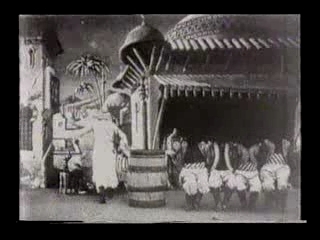Stereotypical Muslim misrepresentation in films is as old as film history itself, if not older, as seen in Orientalist paintings, novels, and plays which pre-date the invention of film by centuries. One of the founding fathers of cinema, Georges Méliès, directed The Terrible Turkish Executioner as early as 1904; in this short film, a Muslim/Turkish executioner chopped off four people’s heads in one swish, with a Sinbad-like sword wearing “typical Muslim garb.” Later, through the visual magic Melies was known for, the chopped heads rolled back to where they belong, and the four took their revenge by chopping off the executioner’s head.
Fast-forward a hundred years to films released as recently as the last 5 to 10 years, and you will see updated versions of the same one-dimensional representation of Muslim characters. The 2008 movie Taken resorted to such an antiquated, comical Arab-Sheik-antagonist, who has a dagger in one hand and a branch of grapes on the other, buying and selling young white virgins. Granted; there have been other films, like Traitor, that have done a much better job showing nuance in the Muslim identity. Yet these films leave the audience with the feeling that complex human Muslim characters are a minority, whereas the majority of Muslims are still blood-thirsty terrorists who have off-the-chart sexual hunger. Variations of these images abound even in the news media. Further added to the public perception of Muslims was the paranoia surrounding the New York City Islamic Cultural Center, and ever-present suspicion about President Obama’s “hidden Muslim identity.”
It is in this cultural milieu that up-and-coming director/writer Qasim Basir attempts to humanize Muslim Americans (and Muslims in general) by highlighting all of their forms and complexities. His feature film, MOOZ-lum, premiered at the 14th Urbanworld Film Festival, and won the best Narrative Feature Film Award. The film breaks the represen-tational boxes into which Muslim characters have historically and repeatedly been forced into. Its title, a play on the popular mispronounciation of the word “Mus-lim,” MOOZ-lum is the story of Tariq Mahdi (played by Evan Ross), a Muslim-American college freshman student who is groping for self-identity. He carries heavy psychological baggage as he is mistreated and beaten by the principal at an Islamic school, where his father, Hassan (played by Roger Guenveur Smith), forcefully sent him in the hope of seeing his son becomes a hafiz (a person who has memorized the complete text of the Qur’an). The film goes back and forth between Tariq’s experiences at the Islamic school and his first days at his new college. He feels totally out of place in both environments, and struggles to feel an affinity to either the Muslim American community or other Americans. His identity crisis comes to a boiling point when the 9/11 attacks occur. The film asks the question: will Tariq navigate the waters of his father’s forced religious identity, or will he strive to discover himself amidst the tumultuous 9/11 atmosphere, while making peace with his religion?
Tariq’s family is African American Muslim, part of the largest Muslim group in the United States. While the center of the drama is on Tariq and his family, the film also includes American Muslims of Indian ancestry and other ethnicities. MOOZ-lum’s true success is its ability to humanize Muslims. They are not the “other,” but are relatable human beings in this film. They do the right things, the wrong things, and everything in between. They learn, teach, grow, take action, get mad, cry, laugh, love, get divorced, and sometimes even redeem themselves. We see a wide spectrum of Muslim Americans, from good and beautiful to bad and ugly, as individual characters rather than one-dimensional stereotypical stick figures.
Tariq’s stress about who he is and what he should be relates directly to the level of in-tensity audiences feel throughout the film. As an African American Muslim, Tariq, is experiencing Du Boisian double consciousness, which in very simple terms is the psy-chological conflict of being “African” and “American” at the same time. But Tariq’s ex-perience is somewhat different from the double-consciousness experienced by most Black Americans. His struggle is about maintaining a healthy duality between the Muslim community on one hand and the overall American public (both black and white) on the other. He is a total failure at this. He does not feel a comfortable connection to either. He changes his name from Tariq to “T” among both Muslims and non-Muslims. To juxtapose Tariq’s unsettled emotional state, director Qasim Basir introduces another character; Professor Jamal (played by Dorian Missick), a young Muslim African American world religions professor. He is a smooth operator when it comes to maintaining his double consciousness, going as “Professor J” among his students, and as Jamal among Muslims. He is comfortable in both worlds. In a way, Tariq is trying to become Jamal, but within his own particular reality.
For years, Muslim women have been portrayed as oppressed, voiceless, and without any agency. A recent example is Sex and the City 2 which portrays women who are independent and free-spirited who do not always follow the ‘social norms.’ But when it comes to Muslim imagery, as Asma Uddin and Sarah Jawaid argue in Sex and the City and Muslim women, this film also buys into convenient visual conventions by “perpetuat[ing] stereotypes of Muslim women as oppressed, silent, and subdued by their apparently necessary counterpart: the violent, angry Muslim man.” Contrari-ly, MOOZ-lum confronts this typical imagery, head-on. Tariq’s mother Safiyah (played by Nia Long) is a strong challenge to the hundreds of Muslim women’s images we come across in the media. She disagrees with her husband about how to raise their children, asks for divorce, puts her husband in his place when needed, and even slaps a man of authority, all the while fashioning her colorful hijab (Muslim headscarf) and walking proudly and comfortably in a mosque. This comes as a fresh breath of air in the midst of all the suffocating one-dimensional Muslim women depictions.
To continue with its challenging of stereotypes, MOOZ-lum also portrays the Qur’an’s place in Tariq’s life with nuance and emotion. The Qur’an has been wrongly contextu-alized and misappropriated in many Hollywood productions, with Qur’anic verses being invoked by Muslim characters before a suicide attack or while chopping someone head’s off “in the name of Islam.” In MOOZ-lum, while a few verses of the Qur’an are recited, they are part of the storyline and are shown within a personal context. Through the act of reciting a verse, Tariq is forced to face the mistreatment he received from his Islamic School teacher and move on with his life as a complete human being, rather than continuing as a fragmented individual lost between two worlds. It is definitely a successful attempt at contextualizing how the Qur’an is experienced in a Muslim’s daily life.
MOOZ-lum is also sophisticated enough to make distinctions between individual char-acters and a whole community or institution. It refrains from making sweeping state-ments. For example, Tariq is not beaten by the Islamic School or Muslims; he is beaten by a demonic/despotic principal. He is yelled at by the father of his childhood love in-terest, who happens to be Christian, not by Catholic School or Christians; he is attacked yet again by a group of white 9/11 revenge mob but not the American public. The film doesn’t conveniently generalize but allows for the opportunity to differentiate between bad apples and rotten trees.
During the climax sequence of the film, right after being attacked by a 9/11 revenge mob, Tariq displays whiplash scars on his back to his family – very reminiscent of the famous 1860’s photos of enslaved African Americans. This display of Tariq’s wounds makes a clear connection between the historical experiences of the Transatlantic Slave Trade and the Muslim Africans enslaved in the United States –- expansively detailed by Sylviane Diouf in her seminal book, Servants of Allah –- and the current Muslim African American existence in the US. This scene calls attention to the oft-forgotten historical contributions of Muslim African Americans to the United States and their particular struggle. At this moment, Tariq’s story resonates with thousands – millions, maybe? – of Black American Muslims who continue their spiritual homecoming vis-à-vis the double consciousness, to find their own voice while simultaneously fighting against extremism, discrimination, and violence both within and without. Furthermore, the West African tune that provides the music bed for the closing scenes and the credit se-quence enhances this moment of resonance. It creates an atmosphere which inspires the audience to flash back to their arrivals at these shores, to their lost languages and cultures, to their religion.
In MOOZ-lum, Qasim Basir has shown an instance of a successful marriage between Black and infant Muslim American cinemas. Without a doubt, he has the potential to become an Oscar Micheaux or a Spike Lee who have been able to operate outside the Hollywood Machine while also impacting mainstream audiences. Mr. Basir brings his Muslim sensitivities to the table while building upon his African American imagery, all wrapped in solid storytelling and riveting drama.
Usame Tunagur is an award winning filmmaker with a Masters of Fine Arts degree in Film from Ohio University. He has directed and produced the short films Muslim 101 and Big Black Good Man, among others. Currently, he produces shows for Ebru-TV, whose mission is to create programming that promotes diversity and multicultural celebration. MOOZ-lum opened nationwide in the following select AMC theaters on Feb 11th, 2011: NYC, DC, Chicago, LA, SF, Philadelphia, Atlanta, Dallas, Houston, and Detroit.





